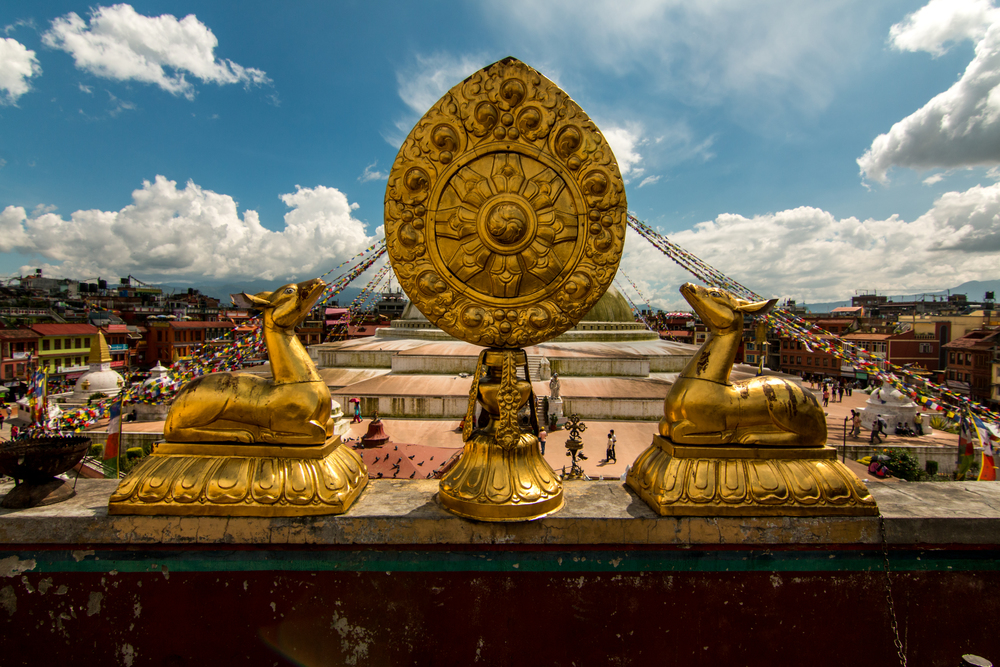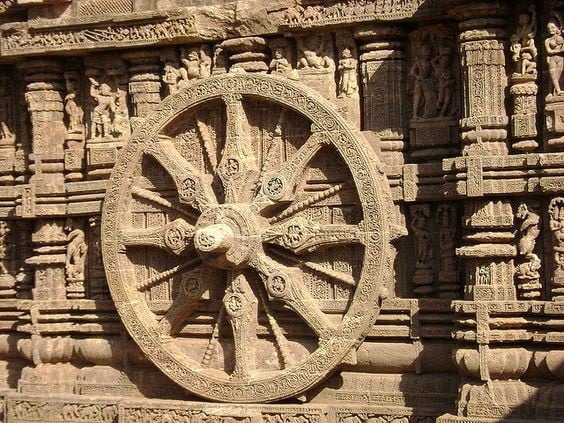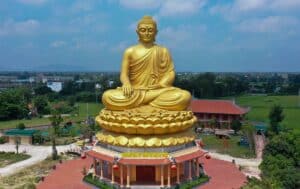When you first dip your toes into the profound waters of Buddhism, one of the earliest symbols you encounter is the Dharma Wheel, or the Dharmachakra. Often seen in the serene hands of various Buddhas and Bodhisattvas, this emblem is far more than an ornate object; it holds within its spokes and rim a deep, symbolic essence pivotal to Buddhist teaching.
This article promises to unravel the layers of meaning behind this ancient symbol, offering you a deeper insight into its spiritual significance and how it continues to guide the path of practitioners around the globe.
What is the Dharma Wheel?
The Dharma Wheel or Dharmachakra, is a profound symbol within Buddhism, encapsulating the essence of the Buddha’s teachings on moral conduct, wisdom, meditation, enlightenment, and liberation. In Sanskrit, “Dharma” translates to law or duty and is phonetically adapted to ‘Dhamma’ in Pali, representing the cosmic law and order as taught by the Buddha, Siddhartha Gautama.
This emblem is not just an ordinary symbol; it is deeply ingrained in the spiritual fabric of Buddhism, serving as one of the Three Jewels or Triratna, alongside the Buddha and the Sangha (the community of monks). Its depiction is almost universal across Buddhist cultures, signifying the teachings of the Buddha that are considered the vehicle to enlightenment and the cessation of suffering, Nirvana.
The Dharma Wheel’s design is rich in symbolism, typically featuring a circle that denotes the perfection of the dharma, the Buddha’s teachings. The hub stands for ethical discipline, essential for mental stability and mindfulness, which are prerequisites for meditation—the path to wisdom represented by the rim. The spokes, varying in number across different traditions, most commonly eight, symbolize the Noble Eightfold Path, a core Buddhist teaching that outlines the right way of living and leads to liberation.
In broader cultural contexts, particularly within ancient Indian and Indus Valley civilizations, the wheel symbolized the sun and motion, embodying life’s cyclical nature and the universe’s dynamism. Within Buddhism, it evolved to signify progress and spiritual change, echoing the Buddha’s first discourse in the Deer Park, where he ‘set in motion the wheel of dharma.’
Furthermore, the Dharmachakra holds a universal appeal, akin to the Cross in Christianity and the Star of David in Judaism, symbolizing the essence and universality of Buddhist doctrine. In various depictions, the wheel’s spokes, rim, and sometimes even color can differ, each adaptation adding layers of meaning and reflecting the diversity within Buddhist practices and interpretations.
Historically, the Dharma Wheel was also a mark of fortune and sovereignty, illustrated by its presence on the soles of the Buddha’s feet in traditional iconography, indicating his divine proclamation and the auspicious nature of his teachings.
History of the Dharma Wheel
The Dharma Wheel, a symbol now deeply connected with Buddhism, has roots that stretch back to early Indian civilization, even before Buddhism began. Initially, the wheel was a powerful symbol of leadership and law, often linked to the Indian god Vishnu and used as a sign of a king’s duty to maintain order and righteousness.
When Buddhism emerged around the 5th century BCE, the meaning of the wheel evolved significantly. The “First Turning of the Wheel of Dharma” refers to Buddha’s first sermon at Sarnath. Here, he shared the Four Noble Truths with his first disciples, marking the wheel’s association with Buddhist teachings. The wheel, particularly with its eight spokes, came to represent the Noble Eightfold Path – a guide to ethical living, mental discipline, and gaining wisdom in Buddhism.
As Buddhism spread across different regions like Central Asia, China, and Southeast Asia, the Dharma Wheel’s use in art and architecture grew. Each culture added its unique touch to the wheel’s depiction. For example, in Tibetan Buddhism, the wheel is often shown with two deer, echoing the Deer Park at Sarnath where Buddha first taught.
The Dharma Wheel’s significance was further boosted by Emperor Ashoka, a major supporter of Buddhism in the 3rd century BCE. He adorned his pillars, stupas, and edicts with the wheel. His version, the Ashoka Chakra with 24 spokes, is now part of India’s national flag, symbolizing the continuous cycle of law.
Today, the Dharma Wheel remains a vital emblem in Buddhism worldwide, featured in various Buddhist sects, from Theravada to Mahayana and Vajrayana. It’s not just an icon; it’s central to many Buddhist rituals, like the Tibetan practice of turning the wheel for spreading spiritual blessings and well-being.
Meaning and symbolism of the Dharma Wheel in Buddhism
Dharma Wheel is a central emblem in Buddhism symbolizing the Buddhist teachings, or the “Dharma.” Its design and elements, steeped in rich symbolism, portray various Buddhist concepts, each illuminating a different facet of the faith. Below, LotusBuddhas will enumerate the primary elements of the Dharma Wheel and the corresponding symbolic significance they each hold within the Buddhist tradition.
- The Wheel: The wheel itself signifies the cycle of samsara. This cyclic existence is a fundamental concept in Buddhism, emphasizing the transient nature of life and the continuous process of change.
- The Hub: The wheel’s hub, situated at its center, signifies moral discipline, considered the crux of leading a virtuous life and a critical step towards achieving enlightenment. The hub stands as the axis of ethical discipline, around which the spiritual life of a Buddhist revolves.
- The Spokes: The spokes of the wheel, traditionally numbering eight, signify the Noble Eightfold Path. Each spoke corresponds to one path: right view, right intention, right speech, right action, right livelihood, right effort, right mindfulness, and right concentration. These paths serve as the practical guide for leading a life of wisdom, ethical conduct, and mental development, ultimately leading to the cessation of suffering and attainment of enlightenment.
- The Rim: The wheel’s rim, holding the spokes and enabling the wheel’s rotation, signifies mindfulness and meditative concentration. It is a reminder of the need to keep one’s spiritual practice consistent and ongoing, keeping one’s progress on the Noble Eightfold Path steady.
- The Wheel’s Motion: The turning of the wheel symbolizes the dissemination or teaching of the Dharma. It is associated with the Buddha’s first sermon, often referred to as the “First Turning of the Wheel of Dharma,” which marked the beginning of the Buddha’s teaching of the path to enlightenment.
- Variations in Spoke Number: In some representations, the Dharma Wheel may have varying numbers of spokes, each having distinct symbolic interpretations. For instance, a wheel with four spokes represents the Four Noble Truths; ten spokes symbolize the ten directions; twelve spokes signify the Twelve Links of Dependent Origination; and twenty-four spokes represent the twelve causes and their cessation.
Dharma Wheel is a complex and multi-layered symbol, serving as a visual summary of fundamental Buddhist principles and teachings. Its design and the symbolism embedded within each of its parts serve to remind followers of the path towards enlightenment and the core practices necessary in the journey. As such, it is more than just a mere emblem; it is a roadmap to spiritual awakening and liberation in Buddhism.
Turning the Dharma Wheel
“Turning the Dharma Wheel” is a powerful metaphor in Buddhism, stemming from Buddha’s first sermon after reaching enlightenment. It’s like setting in motion a great wheel, symbolizing the start of his teachings. This action represents spreading the wisdom of Buddhism, particularly the teachings of the Four Noble Truths and the Noble Eightfold Path.
When someone “turns the Dharma Wheel,” they are actively sharing Buddha’s teachings, aiming to awaken understanding and compassion in others. This involves teaching, discussing, and applying Buddhist principles in everyday life. It’s a way of passing wisdom from teachers to students, keeping the spirit of Buddhism alive through generations.
This metaphorical turning is often described as happening in three main stages or “turnings,” each signifying a different aspect of Buddha’s teachings:
- The First Turning: This is about Buddha’s first teachings at Deer Park. Here, he introduced the Four Noble Truths that explain suffering, its cause, how to end it, and the path to do so. The Eightfold Path, a practical route to enlightenment and ending suffering, was also presented.
- The Second Turning: This phase brought in the Mahayana philosophy. It focused on the idea of emptiness and the Bodhisattva ideal, where one seeks enlightenment for the good of all beings. This turning emphasizes compassion and the universal goal of freedom from suffering.
- The Third Turning: Here, the concept of Buddha-nature was introduced, highlighting the potential within all beings to achieve Buddhahood. This stage covers various later Buddhist teachings, delving into consciousness and the subtle differences in levels of reality.
Each “turning” of the Dharma Wheel unfolds more layers of Buddhist teachings, deepening understanding and offering new paths for spiritual growth. But at its core, the aim remains to end suffering, reach enlightenment, and share these teachings widely for the well-being of all.
The Dharma Wheel in fashion and jewelry
In the world of fashion and jewelry, the Dharma Wheel has become more than just a religious symbol. Its intricate design and rich meaning make it a popular choice for designers looking to add a touch of spirituality, mindfulness, and cultural depth to their work.
In jewelry, the Dharma Wheel shows up in various forms like rings, necklaces, bracelets, and earrings. Its design can be simple and modern or detailed and traditional, depending on what the designer wants to express and the look they’re going for. People often pick Dharma Wheel jewelry not just for its beauty but also for what it represents – wisdom, ethical living, and mental focus. Wearing these pieces can serve as a daily reminder of these spiritual values.
When it comes to clothing, the Dharma Wheel is used in prints and embroidery, adorning everything from casual shirts and dresses to more formal outfits. The design can be a bold, eye-catching feature or a subtle, understated detail. Sometimes, the wheel’s elements are reimagined or stylized into unique patterns, giving a fresh twist to the traditional symbol.
More than just decoration, the Dharma Wheel in fashion and jewelry is also a means of personal expression. It’s chosen by individuals as a symbol of their spiritual connection, their belief in the values it signifies, or their appreciation for Buddhist philosophy and art.
However, it’s important to remember the deep meaning of this symbol. Wearing the Dharma Wheel should be done with respect, understanding its significance, and ideally, with the intent to reflect Buddha’s teachings in one’s thoughts and actions. It’s a way to keep the principles of Buddhism close and to share its message with others through our choice of fashion.










